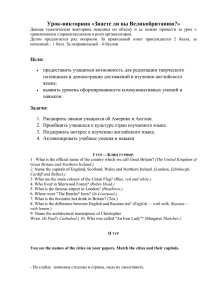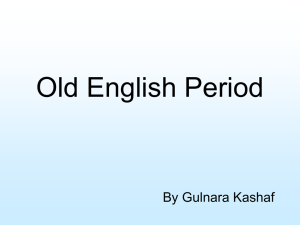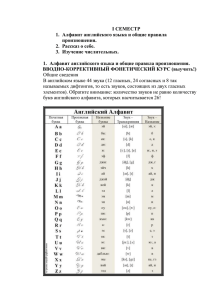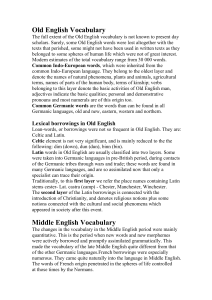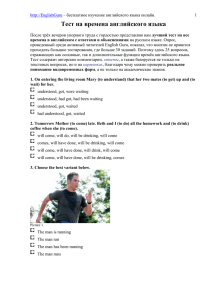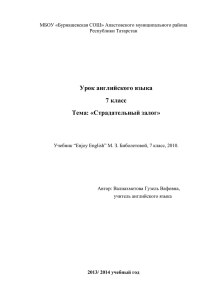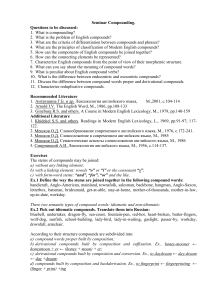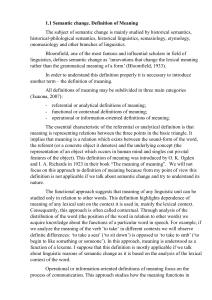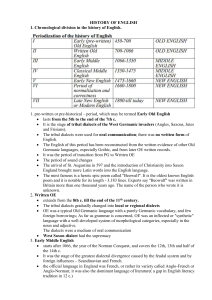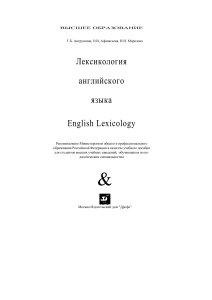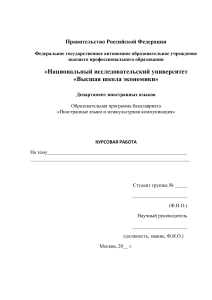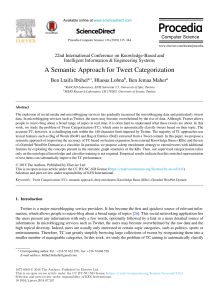Лекция 3. Word and Lexical Meaning.
реклама
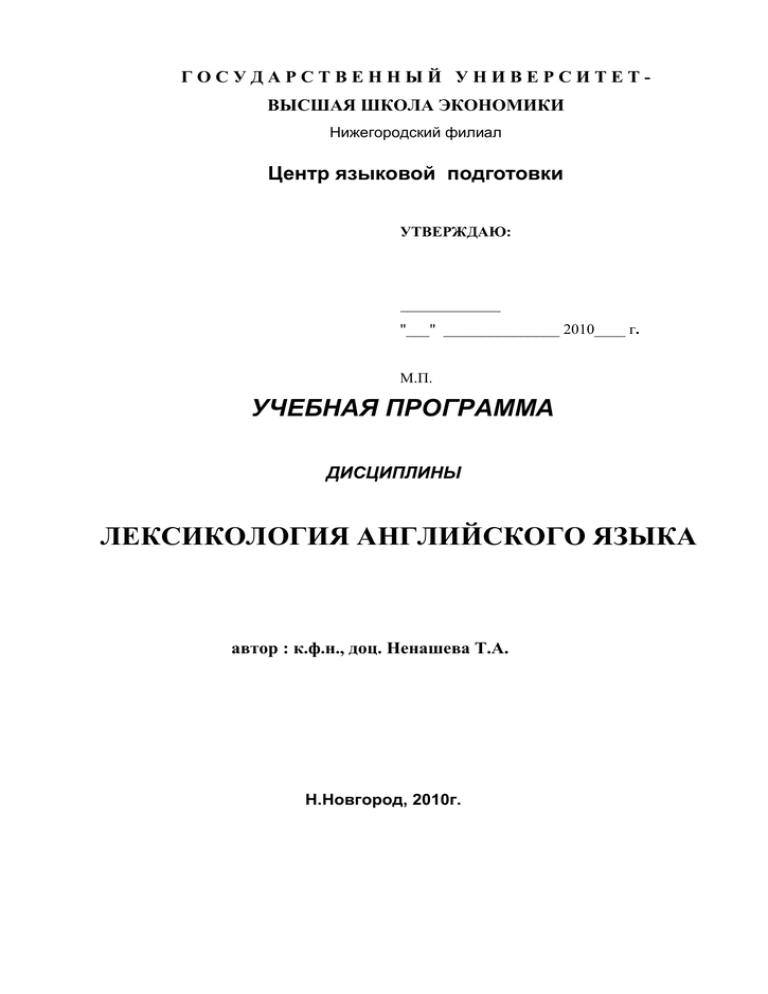
ГОСУДАРСТВЕННЫЙ УНИВЕРСИТЕТВЫСШАЯ ШКОЛА ЭКОНОМИКИ Нижегородский филиал Центр языковой подготовки УТВЕРЖДАЮ: _____________ "___" _______________ 2010____ г. М.П. УЧЕБНАЯ ПРОГРАММА ДИСЦИПЛИНЫ ЛЕКСИКОЛОГИЯ АНГЛИЙСКОГО ЯЗЫКА автор : к.ф.н., доц. Ненашева Т.А. Н.Новгород, 2010г. I. ПОЯСНИТЕЛЬНАЯ ЗАПИСКА Данный курс лексикологии английского языка предназначен для обучения переводчиков в сфере профессиональной деятельности и разработан в соответствии с Регламентом по оформлению, согласованию и утверждению программ учебных дисциплин в структурных подразделениях ГУ-ВШЭ, реализующих программы дополнительного профессионального образования. Программа курса составлена с учетом исходного уровня обучающихся не ниже Intermediate. Курс предполагает 24 часа аудиторных занятий, в том числе лекционный курс в объеме 14 часов и 8 часов практических семинарских занятий. Обучение завершается контролем в форме зачета. Целью курса «Лексикология английского языка» является знакомство с основными положениями теоретической и прикладной лексикологии, формирование представления о месте лексикологии в системе других разделов языкознания. Задачи изучения дисциплины: дать общую характеристику словарного фонда английского языка с точки зрения его этимологического, исторического и территориального состава; проследить основные пути обогащения словарного фонда; изучить основные понятия лексикологии из области семасиологии, омонимии, морфологии, словообразования, сочетаемости лексических единиц; Требования к уровню освоения содержания дисциплины По окончании курса студенты должны иметь следующие знания и навыки: иметь представление о значении и смысловой структуре слова, денотативном и коннотативном значении, типах семантических изменений владеть лингвистическими понятиями полисемия, омонимия, 2 лексические варианты, паронимы; источники омонимии, знать типы синонимов, типы семантической структуры многозначных слов. знать специфику словообразования, морфологическое и деривационное строение слова, способы словообразования в языке, понимать специфику сочетаемости лексических единиц; знать происхождение этимологический состав лексики английского языка, исконной лексики, основные источники заимствований, типы ассимиляции заимствованных слов. иметь представление об изменчивости словарного фонда и историческом составе английской лексики, архаизмов, историзмов, основных способах образования неологизмов. иметь понятие о литературном английском, региональных вариантах и территориальных диалектах английского языка. уметь осуществлять лексикологический анализ текста: характеризовать этимологический состав лексики, определять наличие в тексте американизмов, диалектизмов и т.д., анализировать морфологический состав слова и определять тип и способ словообразования; находить синонимы, антонимы, омонимы, архаизмы, неологизмы. 3 II. КАЛЕНДАРНО-ТЕМАТИЧЕСКИЙ ПЛАН проведения занятий по дисциплине лексикология английского языка в 3, 4 модулях Семинары Лекции Самостоятельная работа Тема кол-во часов 1.Этимологический состав неделя 2 3 2 4 кол-во часов 2 неделя форма 10 английской лексики. Etymological structure of the English vocabulary/ 2.Региональные Выполнение варианты английского практических языка. заданий Regional Varieties of English. 3.Морфологическая структура 2 5 2 11 и 2 6 2 12 слова. Словообразование. Morphological structure of the word. Word Formation. 4. Слово лексическое значение. Word and Lexical Meaning. 4 5.Полисемия и 2 7 1 13 8 1 14 омонимия. Polysemy and Homonymy. 6.Синонимия и2 антонимия. Synonyms and Antonyms. 7.Архаизмы и 2 Выполнение 9 неологизмы. Archaisms практических заданий and Neologisms. 14 ИТОГО ВСЕГО ЧАСОВ 4 24 III. ТЕМАТИЧЕСКОЕ СОДЕРЖАНИЕ ПРОГРАММЫ КУРСА Лекция 1. Etymological Structure of the English Vocabulary. Native Words. Words of the common Indo-European word-stock. Words of the common Germanic word-stock. Peculiarities of native words. Borrowings. Earlier Latin borrowings. Celtic borrowings. 7c. Latin Borrowings. Scandinavian borrowings. Norman-French Borrowings. Latin, Greek, Italian and Spanish borrowings of the Renaissance period. The Enlightenment Period. Minor borrowings. Reasons for Borrowing Words and the Role of Borrowings. Etymological Doublets and Triplets. Assimilation of Borrowings. Types of assimilation. 5 Лекция 2. Standard English.Regional varieties and social variation. Standard English. Received Pronunciation. British English. British Variants. ScottishEnglish. Irish English. British Local dialects. Contemporary tendencies in regional and social variations. American English. Standard American English. Local dialects. Groups of Americanisms. Historic Americanisms. Proper Americanisms. American borrowings. Peculiarities of American English. Phonetic differences. Lexical differences. Grammar differences. Other regional varieties of English. Pidgins and Creoles. Лекция 3. Word and Lexical Meaning. Notion and meaning. Semantic Structure of a Word. Denotational and connotational meaning. Evaluative connotations. Stylistic connotations. Emotive connotations. Cultural connotations. Denotational semantic structure. Connotational semantic structure. Semantic Structure of a polysemantic word. Types of Semantic Change. Specialization. Generalisation. Transfer of meaning. Metaphor. Metonymy. Hyperbole. Litotes. Amelioration of meaning. Pejoration of meaning. Лекция 4. Polysemy. Homonymy. Semantic structure of a polysemantic word. Radiation. Concatenation. Split Polysemy. Semantic structure based on the common connotational meaningHomonyms. Classification of homonyms. Sources of homonymy Лекция 5. Synonyms and antonyms. Paronyms. Types of Synonyms. Ideographic synonyms. Stylistic synonyms. Absolute synonyms. Desynonymisation. Antonyms. Absolute and derivational antonyms. Lexical variants. Paronyms. Лекция 6. Archaisms and Neologisms Archaisms and their stylistic value. Historisms, spheres of their usage. Obsolete words. Neologisms, their classification. Semantic neologisms. Transnomination neologisms. Proper neologisms. Ways of forming neologisms 6 Лекция 7. Word formation Morphological structure of the word. Simple words. Derivatives. Compounds. Major ways of word formation. Affixation. Classification of affixes. Semi-affixes. Valency of affixes. Semantic overlapping. Compounding/composition. Classifications of compounds. Conversion. Shortening/clipping. Secondary ways of word formation. Sound interchange. Stress interchange. Sound imitation. Blending. Back formation. Семинар 1. Etymological Structure of the English Vocabulary 1. Native words, their classification and characteristics. 2. Latin borrowings in English. 3. French borrowings and their influence on the English vocabulary. 4. Celtic and Scandinavian borrowings. 5. Italian, German, Spanish and minor borrowings. 6. Assimilation of borrowings and types of assimilation. Seminar 2. Regional varieties of English. 1. Standard English and RP. 2. Development of British dialects. 3. Standard American English and dialects. 4. Groups of Americanisms. 5. Peculiarities of American English compared to British English. Seminar 3. Word formation 1. Affixation. Classifications of suffixes. 2. Valency of suffixes. 3. Prefixes, their classification. 4. Compounding, classifications of compounds. 5. Conversion 6. Sound interchange, clipping, blending. 7. Distinctive stress, onomatopoeia, back formation Seminar 4. Polysemy and Homonymy 1. Polysemy. Semantic structure of a polysemantic word. 2. Types of semantic structure. 3. Split polysemy. 4. Homonyms, their classifications. 5. Sources of homonymy 7 IV. ФОРМЫ КОНТРОЛЯ ЗНАНИЙ А) Текущий контроль Текущий контроль осуществляется на семинарских занятиях посредством фронтальной беседы по изученным темам и индивидуального опроса студентов по теоретическим темам, а также посредством проверки самостоятельно выполненных практических заданий по отдельным разделам курса. Б) Итоговый контроль Итоговый контроль осуществляется в форме зачета. Зачетное задание включает в себя: 1.Теоретическую часть (ответ на 2 вопроса из лекционного курса по выбранному билету) 2.Выполнение практического задания – лексическая нтерпретация предложенного текста. V. ВОПРОСЫ, ПРАКТИЧЕСКИЕ ЗАДАНИЯ А) ВОПРОСЫ ДЛЯ ПОДГОТОВКИ К ЗАЧЕТУ 1. General etymological survey of the English vocabulary. 2. Native words, their classification. 3. Latin borrowings in English. 4. French borrowings, their influence on the English vocabulary. 5. Celtic and Scandinavian borrowings. 6. Italian, German, Spanish and minor borrowings. 7. Assimilation of borrowings. 8. British English. 9. American English. 10. Regional varieties of the English language. 11. Word and meaning. 12. Semantic structure of a word. 13. Types of a semantic change. 8 14. Polysemy, semantic structure of a polysemantic word. 15. Criteria of synonymy, types of synonyms. 16. Antonyms. 17. Homonyms, their classification. 18. Sources of homonymy. 19. Morphological structure of the word. 20. Word formation. Affixation, conversion. 21. Word formation. Compounding, composition. 22. Shortening and minor ways of word formation. 23. Archaisms, historisms and obsolete words. 24. Neologisms. Ways of forming neologisms. Б) ПЛАН ЛЕКСИЧЕСКОГО АНАЛИЗА ТЕКСТА I. ETYMOLOGY 1. Give examples of native words of the common Indo-European word-stock (cognates in Latin, Greek, German, Russian) and the common Germanic word-stock (cognates in Gothic, German, etc.), characterize their peculiarities. 2. Give examples of borrowings, etymological hybrids and doublets. Characterize them according to their origin (source) and degree of assimilation. Find international words. 3. Try to find archaisms, historisms or neologisms. Characterize them according to the way of formation. II. MORPHOLOGICAL STRUCTURE OF WORDS 1. Analyze several words on three levels: a) on the morphemic level – number of morphemes, their types, free and bound morphemes, root words, derived and compound words; b) on the derivational level – types of stems, simplified stems, roots equal to stems; c) on the Immediate Constituents level, revealing the morphological motivation of words. III. WORD BUILDING 9 1. Give examples of words formed through affixation, characterize prefixes and suffixes according to their origin, meaning, type (convertive or non-convertive), productivity, frequency, stylistic reference, emotive charge, valency, part-of-speech meaning. 2. Give examples of compound words, characterize them according to the type of composition, idiomaticity, the way of joining components. 3. Find examples of words formed through conversion, characterize conversion pairs according to the main points of difference and similarity between the members of a pair; semantic relationship between them; direction of derivation. 4. Characterize examples of other ways of word-building; shortening, blending, back-formation, onomatopoeia, distinctive stress and sound interchange. IV. SEMASIOLOGY 1. Find several (5-6) lexical units with different types and degrees of motivation. 2. Point out instances of semantic change (widening, narrowing, degradation, amelioration of meaning). Characterize different cases of semantic transfer (metaphor, metonymy, etc.). 3. Point out polysemantic words, characterize their lexico-semantic variants. Supply some words in the text with homonyms, speak on their source, type, degree. 4. Define the type and source of synonyms to some words in the text. 5. Find homonyms to several words from the text, define their source and types. В) ПРИМЕРНЫЙ ТЕКСТ ДЛЯ ЛЕКСИЧЕСКОГО АНАЛИЗА THE LONGEST JOURNEY Freeing migration could enrich humanity even more than freeing trade. But only if the social and political costs are contained. «WITH two friends I started a journey to Greece, the most horrendous of all journeys. It had all the details of a nightmare: barefoot walking in rough roads, risking death in the dark, police dogs hunting us, drinking water from the rain pools in the road and a rude awakening at gunpoint from the police under a bridge. My parents were terrified and decided that it would be better to pay someone to hide me in the back of a car." This 16-year-old Albanian high-school drop-out, desperate to leave his impoverished country for the nirvana of clearing tables in an Athens restaurant, might equally well have been a Mexican heading for Texas or an Algerian youngster sneaking into France. He had the misfortune to be born on the wrong side 10 of a line that now divides the world: the line between those whose passports allow them to move and settle reasonably freely across the richer world's borders, and those who can do so only hidden in the back of a truck, and with forged papers. Tearing down that divide would be one of the fastest ways to boost global economic growth. The gap between labour's rewards in the poor world and the rich, even for something as menial as clearing tables, dwarfs the gap between the prices of traded goods from different parts of the world. The potential gains from liberalising migration therefore dwarf those from removing barriers to world trade. But those gains can be made only at great political cost. Countries rarely welcome strangers into their midst. ПРИМЕРНЫЙ АНАЛИЗ ТЕКСТА The text under consideration/analysis is presumably a passage from the article written in Standard English. I have not noticed any Americanisms or features pointing to other regional varieties of English. The style is literary, though the text contains an example of a word belonging to colloquial style: a drop-out. I. ETYMOLOGY From the point of view of etymology the text presents a certain interest. It abounds in borrowed words. There are earlier Latin borrowings such as school, line, border, bridge, Latin-French borrowings table, fortune, there are also words borrowed by many languages which became international words: global, migration, political, liberalise. Among French borrowings there are completely assimilated Norman-French borrowings which are not felt as such: e.g. rich, country, and later French borrowings that are not completely assimilated: phonetically: e.g. police; graphically and phonetically: journey, restaurant). The word paper deserves a particular interest. It is derived from Fr. Papier, which, in its turn, comes from Lat. papyrus, and the latter was borrowed from Greek (Gr. Papyrus). Thus, the source of borrowing (the language from which the word was taken into English) is French, and the origin of borrowing (the language to which the word may be traced) is Greek. ………………… (borrowings from other languages are analysed in the same way). As far as native words are concerned, I can name the following examples of native words of the common Germanic word-stock : fast, the cognate of which may be found in Gothic (G. fest), all, having cognates in Gothic (all) and Old Norwegian (ON allr), death, old, water, world, roads and many more. …………………. (other groups of native words). An instance of etymological doublets can be exemplified by the word road: there is a pair of etymological doublets in the text: road - raid. II. MORPHOLOGICAL STRUCTURE OF WORDS For the morphemic analysis I have chosen the following words: Most, nirvana – one-morphemic root words consisting of free morphemes, Details - a two-morphemic word consisting of a root morpheme detail and a derivational morpheme –s, used to form plural Analysis into the immediate constituents. /See example from the lecture/ ( un - gentlemanly Comparing the word with other utterances we recognize the morpheme un- as a negative prefix (compare unnatural, unfortunate, uncertain) and the morpheme gentlemanly. Thus at the first cut of the analysis we obtain the bound negative morpheme un- and the free morpheme gentlemanly. At the second cut we obtain the following immediate constituents: the noun stem gentleman- which occurs in other utterances and the suffix -ly with the meaning “having the quality of the person 11 denoted by the stem” (compare womanly, masterly, soldierly). The third cut is an adjective stem gentle- (a similar pattern is observed in nobleman) and -man which may be classified as a semiaffix) III. WORD BUILDING Now I would like to analyse the ways of world building used in the text. The word Impoverished is an affixational derivative consisting of four bound morphemes,pover- is a derived stem, im- is a negative prefix of Romanic origin, -ish is a derivational verbforming suffix, and –ed is a functional suffix. Another example of an affixational derivative – youngster( a root morpheme young-, and a semiaffix having a derogatory meaning –ster). High-school is a simple compound. There seem to be no examples of derivational compounds in the text under consideration. There are also words formed by means of other ways of word formation: Conversion : started – a start, rain – to rain, to clear – clear, to drop out - a drop-out, back –to back- the back IV. SEMASIOLOGY Let’s move on to the level of semasiology. In the text the following examples of semantic change may be found: Widening (table, paper), narrowing, degradation, amelioration of meaning . There is also a case of a semantic transfer, it can be demonstrated at the example of … (metaphor, metonymy, etc.). The text contasins numerous polysemantic words: Pool, papers, gap, good etc. Let’s consider lexico-semantic variants of the word table (стол, таблица, пища, плато, доска.) As far as homonymy is concerned, I can give the following homonymic pairs : rain – reign; these are homophones, according to another classification - partial lexico-grammatical homonyms since they coincide only in some forms: compare the paradigms rain –rains- rain’s – rains’ and reignreigns- reigning- reigned). to tear –a tear (is to be analysed in the same way),. In the text we can find the following synonyms: Decide – be desperate to. These are stylistic synonyms. Gap – line – border. This is an example of ideographic synonyms. Horrendous –terrible – horrible – awful. These are ideographic synonyms with a synonymic dominant awful. The synonymic pair horrendous – awful can serve as an example of stylistic synonyms (poetic - neutral). Also: Strangers- immigrants – foreigners – newcomers, misfortune – trouble – difficulty- misery. 12 VII.СПИСОК РЕКОМЕНДУЕМОЙ ЛИТЕРАТУРЫ Основная литература 1. Э.М. Дубенец. Modern English Lexicology. Theory and Practice /Лексикология современного английского языка: лекции и семинары. Пособие для студентов гуманитарных вузов. (на англ. яз.) – М,: «Глосса-Пресс», 2002. – 192 с. 2. Т. А. Ненашева “Seminars in English lexicology” - Учебно-методическое пособие. Н.Новгород, 2007. 3. Douglas Harper. On-line dictionary of etymology. Дополнительная литература 4. I.V. Arnold. The English World /Арнольд И.В. Лексикология современного английского языка: Учеб. Для ин-тов и ф-тов иностр. Яз. (на англ. яз.) –М.: «Высш школа», 1986. – 196 с. 5. G. B. Antrushina, O.V. Afanasyeva, N.N. Morozova. English Lexicology/ Г.Б.Антрушина, О.В.Афанасьева, Н.Н.Морозова. Лексикология английского языка. Учебное пособие для пед. Ин-тов и ф-тов иностр. языков (на англ. яз.): М., «Высшая школа», 1985.–223 с. 6. R.S.Ginzburg, S.S.Khiedekel etc. A Course in Modern English Lexicology / Гинзбург Р.З., Хидекель С.С. и др.: Лексикология английского языка (на англ. яз.) – М. « Высшая школа», 1966. – 275 c. 7. David Christal. The Cambridge Encyclopedia of the English Language.: The Press Syndicate of the University of Cambridge., 1995. – 489 c. 13
